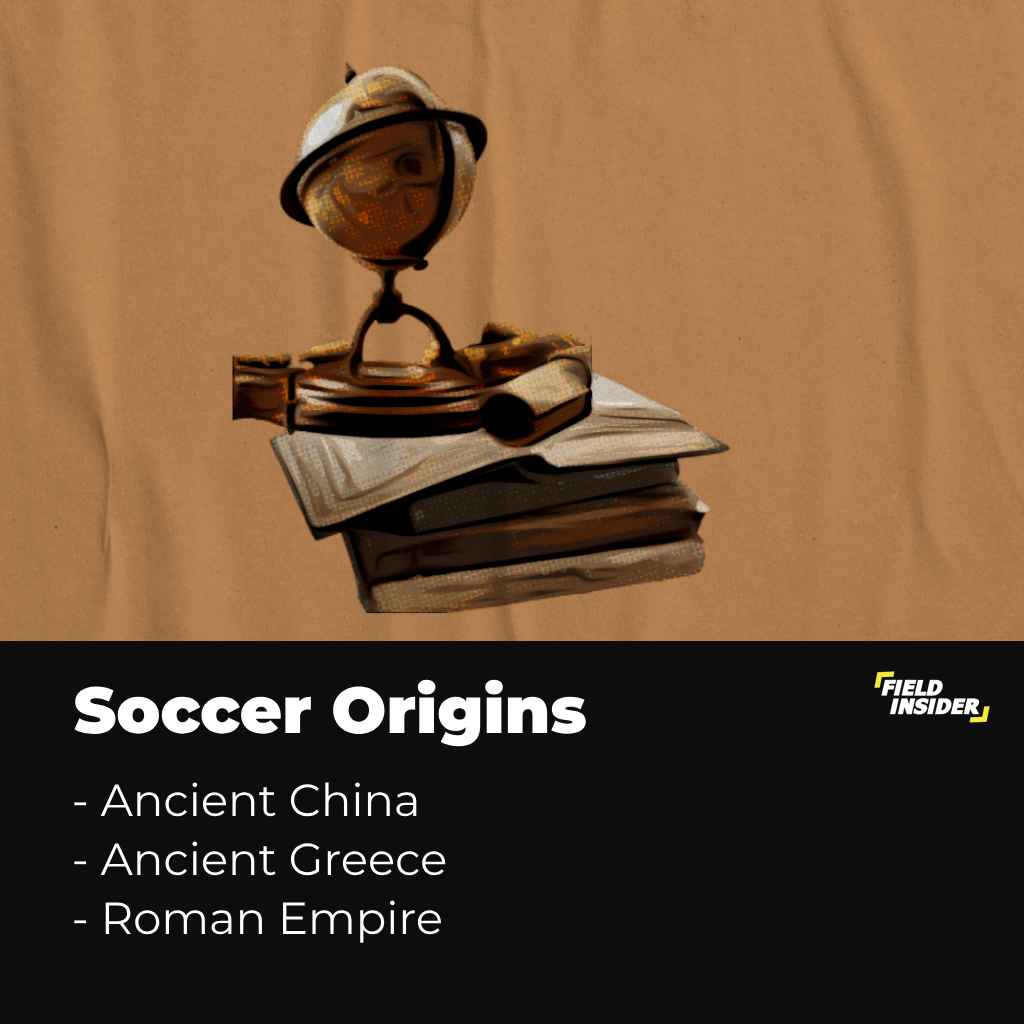How and When was Soccer Invented? Deep Dive
The history of soccer is a long and detailed one, full of interesting facts and stories. The game we know today as soccer has its roots in ancient China, Greece, Rome, and England and may have been invented in these places.
In each of these cultures, there were variations of the game that involved kicking a ball into a goal.
Soccer is one of the most popular sports in the world, enjoyed by people of all ages and cultures. But how did this fascinating game come to be? And how did it grow into the phenomenon that it is today?
Key Takeaway
| Key Aspects | Details |
|---|---|
| Ancient Roots | Traces back to ancient ball games, from China’s ‘Cuju’ to Greece’s ‘Episkyros’ |
| Modern Birth | Soccer’s emergence from England and the establishment of the Football Association in 1863 |
| Global Spread | The spread and development of soccer across the borders of England |
| Rule Evolution | Transitioned from basic to comprehensive rules, including significant changes like the offside rule. |
| Benefits of Football | Relevance and importance of soccer |
| Football Today | How the game of soccer is played today impacts on our lives |
| Future Prospect | Reaching for the future and unveiling how soccer might grow in coming years |
What Does Soccer Mean Today?
Soccer in our society today is the most popular sport in the world, played by millions of people professionally and hundreds of millions for fun and recreation.
In context, according to FIFA, the international regulatory body of football worldwide, there are 265 million registered professional players in the world.
This stands apart from the billions of people who play the sport at their leisure and others who are fans of the game.
However, with this colossal popularity and worldwide acceptance, the question of when and how soccer was invented is something we have to look at.
Soccer’s Origins: References in Ancient History

The origin and historical backtracking lead us to three major origins from three completely diverse groups and cultures. These three backgrounds are what we will be looking at in this section.
Origins From Ancient China
From ancient Chinese origin, soccer began during the Han dynasty, which was between the 2nd and 3rd centuries BC. Back then, in ancient China, it was called Tsu Chu, which meant “Kicking The Ball”.
In addition, this sport was often called CUJU, with Tsu Chu being a popular way of writing it. Nevertheless, they referred to the same thing.
Cuju stands as the closest to the soccer we have today. This is because, just like we have now, the ball could not be handled with the hand, but other body parts like the shoulder, chest, and back were allowed.
Also, the aim of this ancient soccer style in ancient China was to kick the ball into a net that was made from bamboo canes.
Origins From Ancient Greece
From the historical backtracking of ancient Greece, it was found that a sport similar to soccer today was played, and it was called Episkyros.
It was played in 2500 BC, and the aim of the sport was to get the ball to cross the white line at the opponent’s side.
However, one major difference between this game style and what we call soccer today is that players were allowed to use their hands in addition to their legs.
Origins From the Roman Empire
Soccer in the Roman Empire was called Harpastum, and it was obtained from Episkyros in ancient Greece.
Unlike Episkyros, Harpastum was played with a small ball (about the size of that used in softball) and was very violent. There isn’t much known about the sport; however, some sources say it might be the predecessor to today’s modern soccer.
Inception Of Modern Football

Modern football (soccer), as we know it, started in England. It became particularly popular in the 19th century.
Before this time, there were many different versions of the game being played, with each region having its own set of rules. For this reason, in 1863, all these regional soccer associations came together to form the Football Association (FA).
They codified the rules of the game and helped to promote its growth. Moreover, with the formation of the FA came the era of modern soccer.
Today, soccer is played in virtually every country in the world. The game also has a huge economic impact, with billions of dollars spent on transfers, sponsorship, and advertising.
When Was The First Offical Soccer Game Played?
Following the creation of the Football Association (FA) and the rules that accompanied its creation came the first official soccer game.
The game was between Barnes FC and Richmond FC, and it ended in a draw with neither side scoring a goal. This historic matchup took place on December 19, 1863.
When Was The First Soccer League Created?
Another monumental development that followed the creation of the Football Association was the creation of the first soccer league.
This league was called the English Football League, it was founded in England. It was made up of 12 clubs at the time and was founded in 1888.
1888/89 English Football League Season
The inaugural 1888–89 Football League, the world’s oldest professional football league, began in autumn of 1888 and concluded in spring of 1889. Formed in Manchester on April 17, 1888, it featured 12 clubs from the Midlands and North of England.
The clubs, including Accrington, Aston Villa, and others, played each other home and away. Preston North End won the league, remaining undefeated, a feat rarely repeated since. Initially, team rankings were based on wins, draws, and losses.
By late November, a points system was adopted. Two points were given for a win and one for a draw, with goal average breaking ties.
| Position | Team | Played | W | D | L | GF | GA | Points |
|---|---|---|---|---|---|---|---|---|
| 1 | Preston North End | 22 | 18 | 4 | 0 | 74 | 15 | 40 |
| 2 | Aston Villa | 22 | 12 | 5 | 5 | 61 | 43 | 29 |
| 3 | Wolverhampton Wanderers | 22 | 12 | 4 | 6 | 50 | 37 | 28 |
| 4 | Blackburn Rovers | 22 | 10 | 6 | 6 | 66 | 45 | 26 |
| 5 | Bolton Wanderers | 22 | 10 | 2 | 10 | 63 | 59 | 22 |
| 6 | West Bromwich Albion | 22 | 10 | 2 | 10 | 40 | 46 | 22 |
| 7 | Accrington | 22 | 6 | 8 | 8 | 48 | 48 | 20 |
| 8 | Everton | 22 | 9 | 2 | 11 | 35 | 46 | 20 |
| 9 | Burnley | 22 | 7 | 3 | 12 | 42 | 62 | 17 |
| 10 | Derby County | 22 | 7 | 2 | 13 | 41 | 61 | 16 |
| 11 | Notts County | 22 | 5 | 2 | 15 | 40 | 73 | 12 |
| 12 | Stoke | 22 | 4 | 4 | 14 | 26 | 51 | 12 |
Global Outreach Of Football

After the creation of a standardized body (Football Association), rules, and league, the new style of soccer in England began to grow.
First, it became a major sport in England, initially popular among school and college students before eventually gaining the attention of the working-class population.
From here, it spread from city to city across England. Later on, it was carried to other nations by travelers, merchants, sailors, and English soldiers.
When Was The First International Game Played?
Nine years after the creation of the Football Association, the first international soccer game between two countries took place.
On November 30th, 1872, the first international match occurred between England and Scotland. The game, which ended in a draw (0:0) between the two national teams, had an attendance of over 4000.
In addition, a few years later, in 1883, the first international soccer tournament was held. The tournament featured four nations and was called the British Home Championship.
The nations included were England, Scotland, Wales, and Ireland.
Further International Outreach of Soccer
Eventually, the creation of FIFA (Fédération Internationale de Football Association) followed in 1904, and in less than 30 years, the first World Cup tournament was held in 1930.
Today we have had 22 World Cup tournaments, with 80 countries having been represented over the years. In addition, in 1908, soccer became a part of the Olympics.
Introduction Of Soccer In The United States
Soccer in the United States didn’t get much attention until the 20th century, even though it had been around since 1872.
The first intercollegiate soccer match was played in 1872 between Rutgers and Princeton University in New York. Later on, in 1920, there was a rapid increase in the number of soccer players. This occurred mainly due to the inflow of immigrants from Europe.
Unfortunately, this quickly dropped with the Great Depression and World War II. It will eventually take until 1970 before there is another rise in the soccer trend. This is due to the establishment of the professional North American Soccer League, which is now known as Major League Soccer.
Growth Of The MLS
The growth of soccer in the MLS is seeing a steady increase. With the recent influx of superstars (including the signing of Lionel Messi to Inter Miami FC), there is expected to be an even larger audience.
From data gathered from Wikipedia on the steady growth of the average teams and spectators that attend MLS matches, it is evident that the football league is growing.

The chart provided illustrates the growth in the league’s team count over the years. In 2012, the MLS consisted of only 10 teams.
Fast forward to the present day, and we now have a league boasting 26 teams. This indicates significant expansion, with 16 new teams added to the MLS since 2012.

Further proof of the growth of Major League Soccer is the rapid increase in the number of attendees for their games. In the chart, we can again see a consistent leap in the number of people who are fans and attendees of sports games in the MLS.
Evolution of soccer over the years and Rule changes made to the game

Soccer, or football, has evolved over the years, both in terms of its rules and the way it is played. One of the most significant changes to the game came in 1848 when the first set of formal rules were established in in England.
The Cambridge Rule – 1848
The Cambridge Rule came to be from a collective agreement from all the school teachers in South England.
The gathering which took place at Cambridge led to the establishment of some rules that are currently in use in today’s sport.
The most relevant rules were the ones that mandated the wearing of the same jersey color by members of a team and the ban of hands to play the ball among others.
The Sheffield Rule – 1858
The Sheffield rule was another rule implemented by schools and teachers in Northern England. The rules included the introduction of fouls, offsides, throw-in rules, and a set of others.
Football Association – 1863
As mentioned earlier, the first set of official rules made for soccer were made during the creation of The Football Association.
These rules, which had a number of regulations feature rules on the standard size of football fields and the coin toss as well as the kickoff that at the start of a game and after games are scored and a list of other rules. (source)
Introduction Of VAR
Another change in rules was the establishment of the VAR (Video Assistant Referee) approved by the International Football Association Board (IFAB) in 2016.
Its first use in an international friendly match between Italy and France took place on June of 2016. In addition, it was also featured in its first FIFA professional match in 2017 during a FIFA Confederations Cup game.
However, it won’t be until 2018 before it was used again by FIFA at the 2018 World Cup in Russia. This change helped to improve the accuracy of decisions and made the game fairer for all involved.
What are the New Rules introduced in Modern Soccer?
Soccer is constantly evolving and the rules are constantly changing. Some people feel that the changes are to improve the game, while others feel that the changes can make the game more difficult.
The changes that have been made to the game in recent years have definitely had a positive impact on the sport. Players are required to be more fit than ever before and this results in a more exciting and faster-paced game.
Some of the most recent changes are to encourage more attacking play and make the game more exciting to watch.
The rule allowing the goalkeeper to take a step forward when receiving a goal kick has resulted in more shot-stopping saves and more goals being scored from long-range shots.
Another change that has had a positive impact on the game is the introduction of the sin bin. This allows referees to temporarily remove players who commit certain offenses, such as dangerous tackling, without having to show them a red card.
This reduces the number of stoppages in play and helps to keep the game flowing. Players and fans alike can benefit from these changes, which help to make the sport more enjoyable for all involved.
Tactical Evolution
Soccer has also evolved in terms of tactics and style of play.
In the early days of the sport, teams would often line up in a formation known as “the pyramid”, with most of the players clustered around the center forward.
Today, teams often use a variety of different formations, depending on their strengths and weaknesses. As soccer has become more globalized, different countries have developed their own distinct styles of play.
Soccer has undergone a process of constant evolution, with different countries putting their own spin on the game. Brazil is famous for its creative and attack-minded approach, while Italy is remembered for its defensive solidity.
Whereas, the main focus of Spain is on technique and tactics, resulting in a more strategic style of play. No matter what country you’re in, though, soccer is sure to be a part of it.
Benefits of playing soccer and why it is such a popular sport
Soccer has many benefits that contribute to its popularity, for one, its a great way to stay physically and mentally healthy.
This game requires players to run, jump, and change directions quickly, all of which are excellent exercises for improving cardiovascular health, flexibility, and coordination.
Soccer provides a great opportunity for social interaction, it also gives people a chance to bond with others who share their interests in the sport.
In addition, soccer is played almost anywhere, making it a convenient and accessible form of recreation. For all these reasons and more, people of all ages and backgrounds around the globe enjoy soccer.
Soccer In Our Current Society
In our contemporary society, soccer has become deeply embedded in the modern landscape, with nations actively promoting its growth within their borders.
Soccer now serves as a global unifying force, bridging gaps between races, nations, and cultures. It has become a widely beloved sport for recreation and fosters connections when shared passions are involved.
Furthermore, the sport has reached a massive scale, capturing the attention of people worldwide. Prominent leagues like the Premier League, La Liga, Serie A, and others have captured the hearts of millions across the globe.
In today’s world, people are increasingly interested in the intricacies of football, including transfer news regarding their favorite teams and player performances.
Most Famous soccer players and teams/clubs throughout history

When it comes to identifying the most famous player of soccer, there can be some debate.
Some people argue that it is Lionel Messi, who has achieved remarkable success with both his club team, Barcelona, and the Argentine national team.
Others contend that Cristiano Ronaldo, who has won numerous titles with both Real Madrid and Juventus, is the more famous player.
There can be no denying that both Messi and Ronaldo are household names in the soccer world, and they are both deserving of their fame.
However, aside from them, there are many other remarkable players. The table below shows some of the most renowned footballers and their nationality
| Football Players | Nationality | Years Active (Senior Career) |
|---|---|---|
| Cristiano Ronaldo* | Portuguese | 2002-… |
| Lionel Messi* | Argentinian | 2003-… |
| Neymar Jr* | Brazilian | 2009-… |
| Kylian Mbappe* | French | 2015-… |
| Pele | Brazilian | 1956-1977 |
| Diego Maradona | Argentinian | 1976-1997 |
| Zinedine Zidane | Algerian/French | 1989-2006 |
| Gerd Müller | German | 1963-1981 |
The Future of Soccer and Where it is Headed
There are a number of factors that point to continued growth for the sport;
- First, the game is extremely accessible and can play anywhere. All you need is a ball, and you can have a match.
- Second, soccer has a global appeal and is usually played in nearly every country in the world. This gives the sport a huge potential audience.
- Third, soccer is a relatively inexpensive sport to play, which makes it an attractive option for families and individuals on a budget.
- Finally, soccer is a relatively safe sport, which is important for parents who are concerned about their children’s safety.
All of these factors point to continued growth for soccer in the years to come. The sport has a bright future, and will only continue to grow in popularity. Soccer is here to stay – so get out there and start playing!
Conclusion
Soccer has always been a fascinating sport. It is one of the most popular sports in the world, and its popularity continues to grow.
The new rules in modern soccer games have made the sport even more exciting to watch. Some of the benefits of these new rules include faster play, more goals, and less fouling.
Soccer’s role in modern society is complex and influential. It is a reflection of our cultural, economic, and social realities, while also serving as a powerful force for bringing people together.
As the world continues to evolve, so too will the role of soccer within it, adapting and resonating with each new generation








